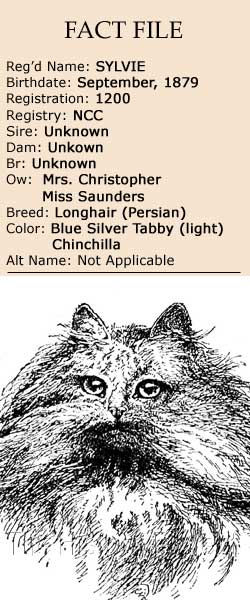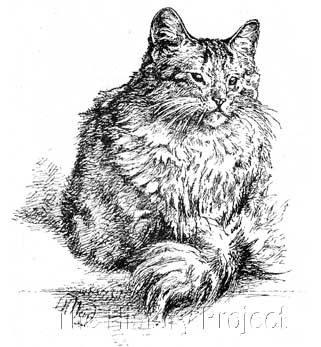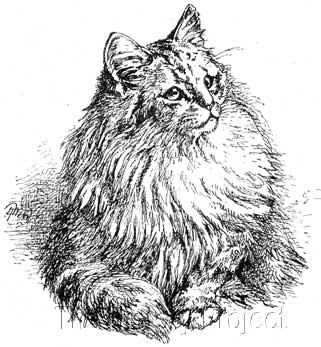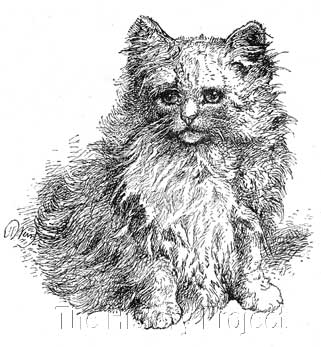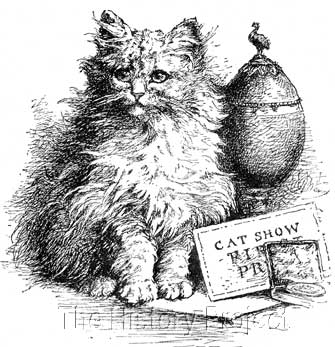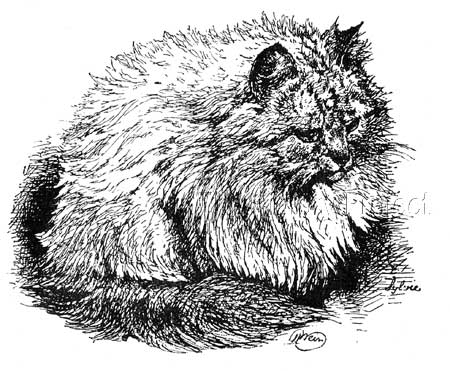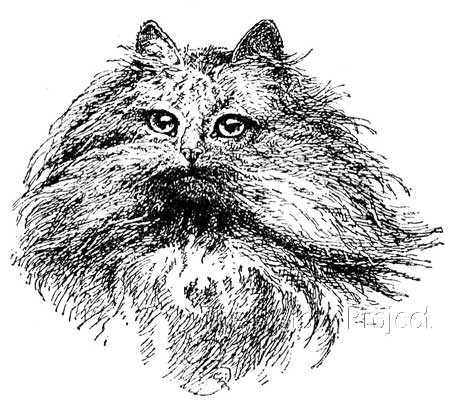 | |||||||||||||||||









|
SYLVIE (1879)PHOTOS | SOCIAL MEDIA | REFERENCES
HISTORICAL BACKGROUND:When fellow author Gillian Vine, wrote her chapter on 'Silver Longhairs' in 1978, she headed it with the title "Ethereal Silvers Win All Hearts"; a statement that could not have been closer to the truth. From the very beginning, silver tabbies, with their striking markings, then lighter silver tabbies and eventually shaded silvers and clear-coated Chinchillas, have caught the imagination of breeders and cat fanciers alike. But it is to the words of Mrs. Balding, (formerly Miss Dorothy Gresham) and the owner of the famed 'Silver Lambkin' that we turn for a clear description of the appearance of clearer coated Silvers. "It is something like twenty years ago that, amongst the competitors in the classes for long-haired tabbies, at the Crystal Palace and other important shows, was occasionally to be seen an alien with the ground colour of the silver tabby, but with very few stripes on the body. These cats were evidently sports from the silver tabby, so much so that the class for that section was the only one open to them; and, although they invariably showed great quality, breeders were loath to exhibit them in the medley of different coloured tabbies, where one of their chief beauties - the absence of stripes - became a disadvantage." "Amongst these outcasts, was a cat of striking beauty, whose like has not been seen again. This was 'Sylvie,' of unknown pedigree, owned by the late Mrs. Christopher, at whose death she became the property of the late Miss Saunders of Peterborough. A beautiful portrait of this exquisite chinchilla, is given in Mr. Harrison Weir's book 'Our Cats'. When judging at the Crystal Palace in 1886, this connoisseur and judge of world-wide repute awarded her first prize, medal and special for the best long-haired cat, getting over the difficulty of her silvery, unmarked coat, by calling her a very light blue tabby, though the puzzle was to find the tabby."2 And thus, even before a class for the 'Self-Silver' or 'Chinchilla' was even created, the existence of a clearer coated silver is confirmed, and the desire to emulate the ethereal beauty of 'Sylvie' firmly established. PARENTAGE & OWNERSHIP:
Unknown
Unknown
| Unknown
Sylvie, Sep-1879, Silver Tabby, F
| Unknown
Unknown
Unknown
Born in 1879, to some extent at least, Sylvie has been largely overlooked as the 'genesis' of the desire to create the erroneously named 'Self-Silver', or a silver cat without tabby marks or barring, which eventually developed into what became the modern day Chinchilla.
But in fact, she caused a sensation when shown at the Crystal Palace in 1886, when she came to the attention of the judge, and was assessed by the keen and observant eyes of the ubiquitous Mr. Harrison Weir. Although entered by her then owner, Mrs. Christopher, into the only class available to her at that time, she was an unlikely candidate for a win, being as she was forced to be entered into a mixed class of what were generally considered to be poor silver tabbies, lacking in barring. There clearly existed an unrecognised desire amongst breeders to create a silver cat without barring, and the action of Mr. Weir in recognising the obvious qualities of a cat which most closely resembled this desire, no doubt helped to encapsulate and promote the idea amongst fanciers, who from that moment forward seemed to gain the courage to forge ahead with even more determination, in the creation and development of a clear-coated silver Persian. Harrison Weir's courage, in so doing, became the 'wind beneath the wings' to a new generation of breeders of 'chinchillas'. Frances Simpson, in her chapter on 'Silver or Chinchilla Persians', elaborates on the lack of a suitable class: "Previous to the introduction of a Chinchilla class at the Crystal Palace in 1894, the class for Silver Tabbies included blue tabbies 'with or without white', and it is curious to read in the old catalogues of the Crystal Palace shows, the titles given to the various cats by the owners, some describing their cats as 'chinchilla tabby', 'light grey tabby', 'silver grey', 'silver chinchilla', 'blue or silver striped'. We may infer that these cats were either blue tabbies or silver tabbies or something betwixt and between."2 SIBLINGS & SHOWS:'Sylvie' was in fact drawn by Harrison Weir, not once but twice, with both illustrations of her being published in his epic work, 'Our Cats' published in 1889. That she was an influential cat and that he was proud to be associated with her winning ways, is evidenced by her double appearance in this work. The first illustration is a whole body image, appearing on page 24, and in the list of illustrations, she is described by the artist in the following terms: "Miss Saunders very light Blue Tabby, 'Sylvie'. A great beauty and winner of first prize, silver medal, and silver sugar basin, at the Crystal Palace 1886, as the best long-haired cat in the show; then the property of Mrs. Christopher."1 When Mrs. Balding explains that Harrison Weir got "..over the difficulty of her silvery, unmarked coat, by calling her a very light blue tabby, though the puzzle was to find the tabby.." she inadvertently hit upon the crux of what 'he' had also unwittingly achieved. He recognised Sylvie for the beauty of her luxurious clear silver coat, but he continued to refer to her as a 'tabby', and by doing so, he had stumbled upon a truth of fact - that all clear-coated silvers were still genetically tabbies! They remained in essence 'agouti' cats, but with a great difference ... that the pattern was prevented to show itself effectively due to the presence of the "inhibitor" factor. Of course, none of this was known in the 1870's, but what the breeders of the time were unknowingly doing, was 'selecting' for the degree of expression or action of 'inhibitor' factor in their cats, and by so doing, creating bloodlines which would self-perpetuate this action through line-breeding. BREEDING & PROGENY:There are no official records of progeny from 'Sylvie'. But wins by other early silvers with minimal barring followed. These included Miss F. Moore's long-haired kittens 'Dinah' and 'Chloe', both of whose likenesses were captured by the pen of Harrison Weir. As kittens they won first prize and a medal at the Crystal Palace Show, as well as at the Brighton and Bexley Cat Shows of 1887.
Again, from Mrs. Balding (formerly Dorothy Gresham), we gain clarification of other early clear-coated silvers who turned heads while there was yet no dedicated class for them: "Another chinchilla of the early eighties was Miss Florence Moore's 'Queenie', who would, had chinchilla classes been provided at that time, have been loaded with championships and honours. In colour she was as light as any of our present-day celebrities, and might easily, from her freedom from markings, have earned the dubious compliment of the uninitiated so highly prized by owners of chinchillas of being mistaken for a grubby white." "……two never to be forgotten pairs of chinchilla kittens - Miss Florence Moore's 'Chloe' and 'Dinah' , winners of first and medal on three consecutive occasions at the Crystal Palace, Brighton and Bexley, 1887 (they being the only chinchillas at any of these shows), and Miss Gresham's 'Silver Lambkins', who swept the board in 1888, winning the specials at the Crystal Palace from forty-six pairs of other competitors of all colours - could in each case, trace descent to the Cheltenham stock , 'Chloe' and 'Dinah' through the aforementioned 'Judy' and the 'Silver Lambkins' through their sire 'Rahman', bred by Mrs. Brydges."
PHOTOS:
SOCIAL MEDIA :None currently available. In Summary: It seems fitting that Mrs. Balding's own Silver male, a later 'Silver Lambkin' by 'Champion Perso' and out of 'Beauty of Bridgeyate' should be designated as the 'father' of the Chinchilla breed, although a study of silver pedigrees would tend to suggest that his dam, 'Beauty of Bridgeyate' could be equally deserving of the honour as a 'foundation' of this colour variety. In any event, this 'Silver Lambkin' became the prime progenitor of this ever popular breed, so much so, that when he passed away late in 1906 at the ripe old age of 17 years, his death was widely reported in the press, the news reaching even to the farthest corners of the globe! But it is important that we not forget that the dream to produce the Chinchilla, first took flight in 1886, well before the birth of 'Silver Lambkin', with the classic win by a clearer coated silver female, named 'Sylvie', whose natural form and beauty of colour and coat, captured the eye and imagination of the greatest of cat fanciers, Mr. Harrison William Weir. Mrs. Balding was careful to note this for us, and it is to her, to whom we turn, in recognition of her great work with the Silver Persian, moulding what was initially only a hope and a dream, into a worldwide reality. REFERENCES:
Registers associated with this article include The Incorporated Cat Fanciers Association of Great Britain (TICFAGB), National Cat Club (NCC), The Cat Club (CCR), Beresford Cat Club (BCC), Feline Federation Francaise (FFF), Siamese Cat Registry (SCR), US Register & Studbook for Cats (USR)including Supplement(USRS), The Studbook of the American Cat Association (ACA), and the Studbook & Register of the Cat Fanciers' Association (CFA).
|
||||||||||||||||
Home | Cats | Gallery | Clubs | People | Artifacts | Articles | Updates | Contact Us ©The CFA Foundation, Inc and The Harrison Weir Collection
|
|||||||||||||||||
